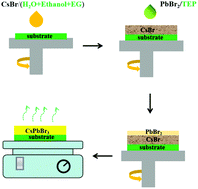A sustainable solvent system for processing CsPbBr3 films for solar cells via an anomalous sequential deposition route†
Abstract
Toxic solvents used in the fabrication of perovskite films are a non-ignorable obstacle for the commercialization of perovskite solar cells (PSCs). CsPbBr3 based solar cells have attracted increasing attention due to their high stability in ambient air. Usually, a traditional sequential deposition route is employed to fabricate CsPbBr3 films, in which toxic DMF and methanol are separately used to dissolve PbBr2 and CsBr. In order to eliminate the solvent toxicity during the fabrication of CsPbBr3 films, we develop an anomalous sequential deposition route to prepare CsPbBr3 films. In this new route, a green solvent system composed of water with the addition of appropriate ethanol and ethylene glycol (EG) is developed to prepare the CsBr solution, and a green solvent, triethyl phosphate (TEP), is used to prepare the PbBr2 solution. Different from those obtained by the traditional sequential deposition route, CsBr films are firstly prepared from their solution, then reacted with PbBr2 through a dynamic spin-coating process, and subsequently transformed to CsPbBr3 films via annealing treatment. As a result, solar cells based on the device configuration of FTO/TiO2/CsPbBr3/carbon exhibit a power conversion efficiency of 6.86%, which is comparable to that of the PSCs prepared through the traditional sequential deposition route using toxic solvents. This work provides an environment-friendly route to prepare CsPbBr3 perovskite solar cells without efficiency loss.



 Please wait while we load your content...
Please wait while we load your content...